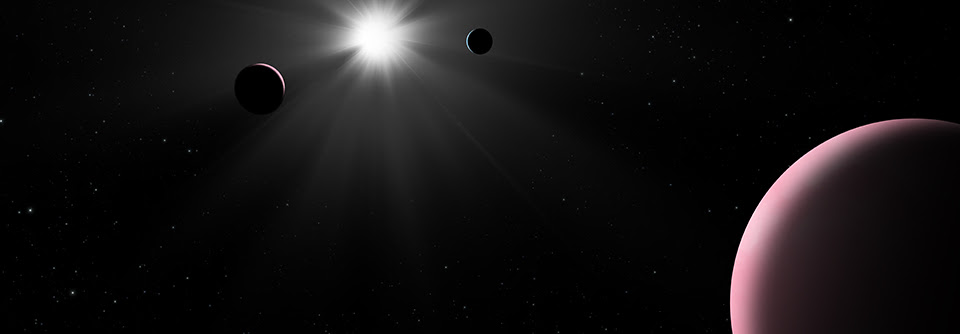An international study, which has the collaboration of several researchers from the Institute of Astrophysics and Space Sciences (IA), used the satellite Cheops, of the European Space Agency (ESA), to observe the star Nu2 Lupi and its two innermost planets, known to transit the star. What the team didn't expect was to see the third planet, an aquatic planet with an orbit of more than 100 days, appear by surprise in the Cheops data, also transiting the star.
Laetitia Delrez (U. Liege) the first author of the published article in the magazine Nature Astronomy comments: «We had as objective to continue the studies of the star Nu2 Lupi and to observe the exoplanets “b” and “c” passing in front of the star, but during a transit of the planet “c” we noticed something fantastic: an unexpected transit of the planet “ d”, which orbits farthest from the star».
At a distance of 48 light-years from Earth, the star belongs to the constellation Lobo (Lupi) and is bright enough to be visible to the naked eye.
Its three known planets (designated Nu2 Lupi b, Nu2 Lupi c and Nu2 Lupi d) were detected in 2019 by the spectrograph HARP, installed in the 3,6 meter telescope of the European Southern Observatory (ESO), by the method of radial velocities.
Subsequent observations using the satellite TESS, from NASA, showed that the two innermost planets, with orbits of 11,6 and 27,6 days respectively, transited their star, but it was unknown that planet “d”, with an orbit of about 107 days, also passed in in front of your star. If it orbited the Sun, Nu2 Lupid would be located between the orbits of Mercury and Venus.
Susana Barros (IA & Department of Physics and Astronomy da UPorto Faculty of Sciences) emphasizes the importance of studying exoplanets simultaneously through the methods of transits and radial velocities, which together allow: «measure their diameter and inclination of the orbit and then calculate the mass. Knowing the mass and diameter of the planet, we can establish limits to its composition, that is, the amount of rock, ice and gases that compose it».
One of the biggest challenges of modern astronomy is to study atmospheres of small exoplanets, with sizes between Earth and Neptune, but most of the long-period exoplanets discovered so far transit dim stars, which makes observation of their atmospheres almost impossible.
Thus, one of Cheops' great goals is to find preferred targets for these studies. the opinion of Olivier Demangeon (IA & DFA-FCUP) is that «being one of the three brightest stars known with exoplanets with these characteristics, Nu2 Lupi is a perfect example of a preferred target. It would not be surprising that in the near future many innovative discoveries related to the atmospheres of these planets would emerge».
Sérgio Sousa (IA & uport), one of the Portuguese representatives in the municipality of CHEOPS consortium, underlines that, despite being a small ESA mission, Cheops continues to demonstrate its enormous capability by catching this unlikely transit of a long-term planet in the Nu2 Lupi system: “This high photometric accuracy is only possible because we are make observations outside our atmosphere, while trying to understand and correct systematic errors in the instruments, characteristic of Cheops observations».
Together with the known data, Cheops' high accuracy allowed the team to determine that planet “d” is about 2,5 times the diameter of Earth, but a mass 8,8 times that of our planet.
Its composition will be similar to that of planet “c”, both being aquatic planets, involved in atmospheres of hydrogen and helium. It is estimated that almost 1/4 of the composition of both will be formed by water, so they will have a lot more water than Earth. The composition of planet “b” seems to be mostly rocky.
The CHEOPS consortium is led by Switzerland and ESA. It has the participation of 11 European countries, and in Portugal the scientific participation is led by the IA.
The participation of the IA in the CHEOPS consortium is part of a broader strategy to promote research on exoplanets in Portugal, through the construction, development and scientific definition of various instruments and space missions, such as the CHEOPS or the spectrograph ESPRESSO, already in operation at the Paranal Observatory (ESO).
This strategy will continue for years to come, with the launch of the space telescope PLATO (ESA), and the installation of the HIRES spectrograph on the largest next-generation telescope, the ELT (ESO).





















Comments